火星 ALPO-Japan Latest

Mars Image 2018/06/20(UT)
Guilherme Grassmann,Clyde Foster,Stanislas Maksmowicz,Joaquin Camarena,Gary Walker,Antonio Lasala Garcia,John Sussenbach,Anthony Wesley,Avani Soares,Gianluca Bianchi,Jean-Luc Dauvergne,Christophe Pellier,John Boudreau,Paul Maxson
G.Grassmann,C.Foster,S.Maksmowicz,J.Camarena,G.Walker,A.Lasala,J.Sussenbach,Anthony.W,A.Soares,G.Bianchi,JL Dauvergne,Christophe.P,J.Boudreau,P.Maxson
解説(安達)/ Comment by Makoto Adachi
6月19日、Solis Lacus付近に発生したダストストームは大きく広がることなく、南に移動した。また、時を同じくしてDaedariaに発生
していたダストストームも、大きくならずに南に移動している。この付近のダストストームは、なかなか広範囲に広がらないよだ。Clyde
Foster氏の画像ではArsia Silvaの南側にも小さく発達したダストストームが見られる。これらの様子は、高地の地形が関係しているかも
しれない。一方、Syrtis Majorの先端部に新たなダストストームが発生している。
Aurorae Sinus-Solis Lacus-Mare Sirenum-Mare Cimmeriumとダストストームの広がりにくい地方が、今日も続いている。この地方の南側は、
朝霧がよく目立ち、青画像でも極冠と同じくらい目立っている。
Gary Walker氏、John Boudreau氏の画像には大きな馬蹄形の晴れ間が記録されている。非常に目立つ晴れ間で、気流の流れの影響を受けて
できたものと思われる。馬蹄形の東にはSolis Lacusのある高地があり、そこから流れてくる気流との関係が疑われる。
Anthony Wesley氏は、南極冠にダストのベルトが侵入している様子を記録している。また、暗色模様がある部分は、ダストストームの
濃さが淡くなっている様子がわかる。
On June 19th,the dust storm that occurred near Solis Lacus did not spread widely and moved south. Also at the same time the dust storm
occurring in Daedaria also moved to the south without increasing in size. The dust storm near here does not spread very widely. In the image
of Clyde Foster,small developed dust storm can be seen on the south side of Arsia Silva. These situations may be related to the terrain
of the highlands. On the other hand,a new dust storm occurs at the tip of Syrtis Major.
Aurorae Sinus - Solis Lacus - Mare Sirenum - Mare Cimmerium and the region where the dust storms are difficult to spread is continuing today.
On the south side of this district,the morning fog stands out well,and even the blue image is as prominent as the polar cap.
Mr. Gary Walker,John Boudreau's image has recorded a large horseshoe-shaped sunset. It is a very conspicuous sunny day,
it seems to have been made influenced by the flow of air current. In the east of the horseshoe shape there is a highland with Solis Lacus
and the relationship with the air current flowing from there is suspected.
Anthony Wesley records the dust belt intruding into the SPC. Also,in the part with the dark pattern,you can see that the dust storm is dark.
(by 13 observations ;reported by Makoto Adachi)
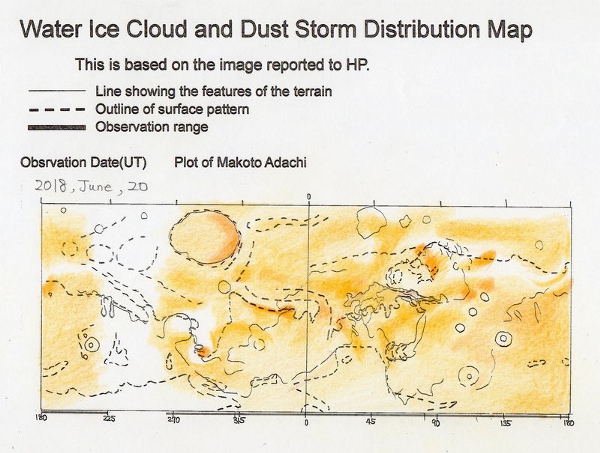 -------------------------------------------------------------------------------------
-------------------------------------------------------------------------------------
 [Guilherme Grassmann,Americana-San Paulo,Brasil]
[Guilherme Grassmann,Americana-San Paulo,Brasil]
A quick pre-sunrise IR capture from this morning which let me have a relook at the Tharsis region.
Although the Tharsis volcanoes can be seen,including Olympus Mons,contrast appears to be low.
Isolated dust clouds may be seen across the southern albedo features.
 Limited to a single IR capture yesterday evening.
Nice to see the familiar shape of Sinus Sabeaus and Sinus Meridiani starting to reappear through the dust.
Hopefully Opportunity rover will start seeing a bit of sunlight on its solar panels.
Limited to a single IR capture yesterday evening.
Nice to see the familiar shape of Sinus Sabeaus and Sinus Meridiani starting to reappear through the dust.
Hopefully Opportunity rover will start seeing a bit of sunlight on its solar panels.
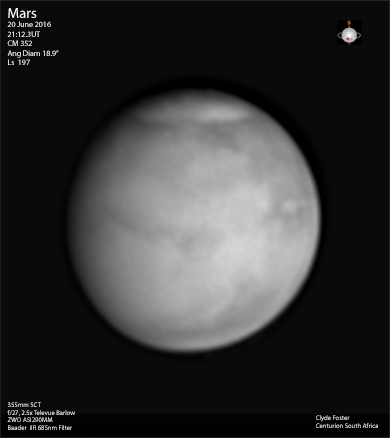 [Clyde Foster:Centurion,South Africa]
[Clyde Foster:Centurion,South Africa]
The atmosphere was globall dusty and the storm itself appeared ocre color.
The polar cap was also affected by a thin dusty layer as〓its color was slightly ocre.
On the phase side of he planet almost featureless,sinus meridiani
(may be also margaritifer sinus) was there through the dust cloud but faintly rather as usual.
The boundary limit of the cloud was suggested on the drawing.
The polar cap occulted slightly by dust haze was bordered by a dark collar with a contrast lowered by dust.
Notes are mentionned on the sketch,the observation level was quoted average to average good on some momments.
The planet size disk helped for performing the present report in spite of the low elevation above horizon of the planet.
Nothing more.
 [Stanislas Maksymowicz Ecquevilly,France]
[Stanislas Maksymowicz Ecquevilly,France]

 [Joaquin Camarena:Spain]
[Joaquin Camarena:Spain]
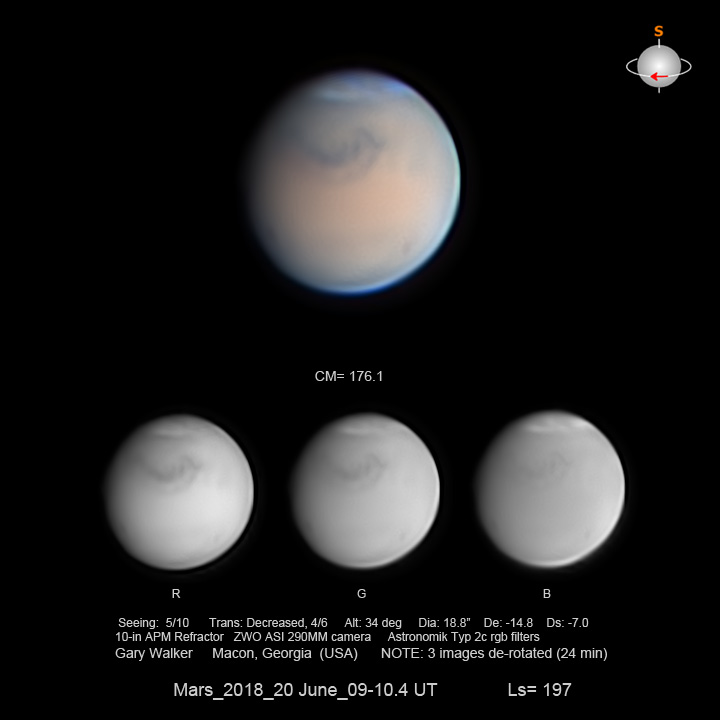 [Gary Walker:Georgia:USA]
[Gary Walker:Georgia:USA]

 [Antonio Lasala :Morata de Jalon:Spain]
[Antonio Lasala :Morata de Jalon:Spain]

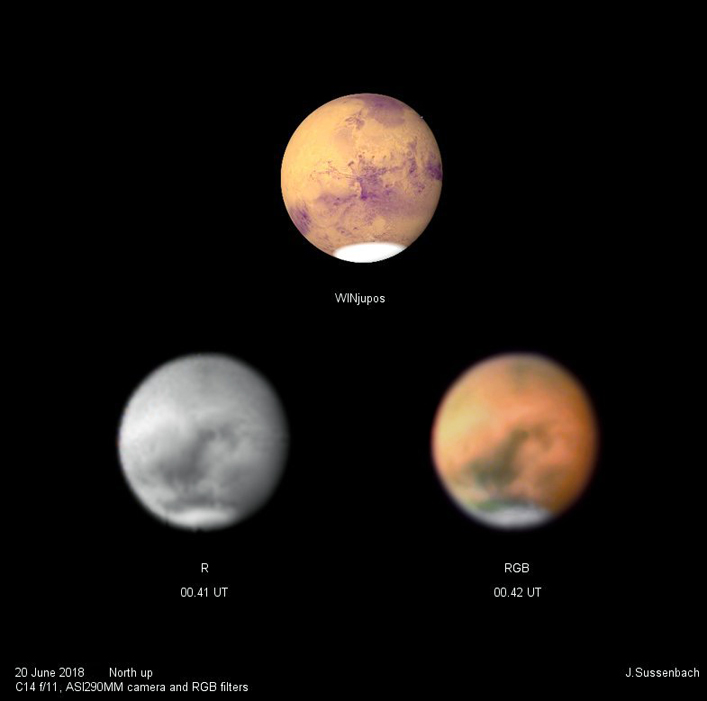
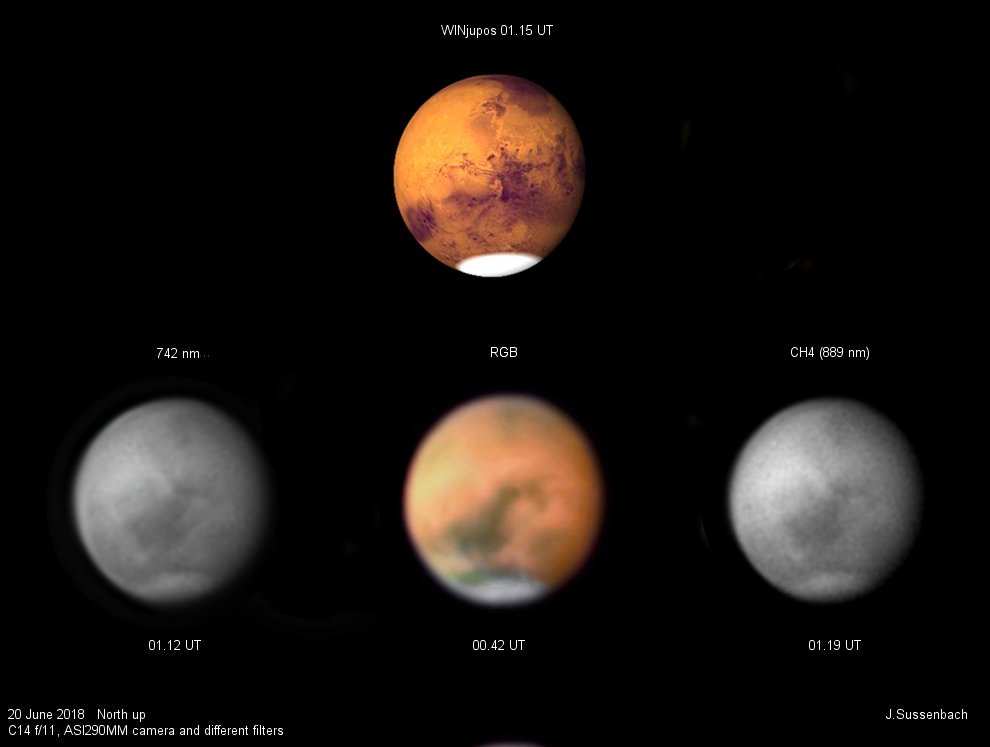 [スセンバッハ:オランダ]
[John Sussenbach:Houten,Netherlands]
[スセンバッハ:オランダ]
[John Sussenbach:Houten,Netherlands]
Hi all,here's a couple of images of Mars from this morning.
One is an IR image showing that most of the surface is still obscured by dust,
however it appears to be less than yesterday. The northern tip of Syrtis Major can now be seen.
Hellas is also visible at lower left.
Much of the south polar cap is covered,however there are some strips of bright ice visible.
This is the same pattern as yesterday,making me think this is a static covering of dust on the ice.
The Opportunity rover is located left of centre in this image,as shown on the WinJupos image by the small circle.
Maybe the sky around there will be starting to lighten as we can start to see more of the surface.
 The second image is an IR-RGB composite.
showing how Mars might appear if our eyes could see further into the infrared.
The second image is an IR-RGB composite.
showing how Mars might appear if our eyes could see further into the infrared.
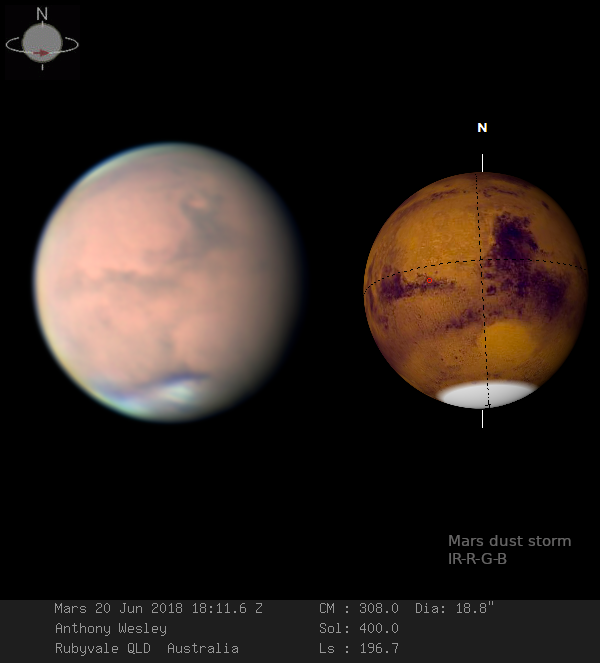 [Anthony Wesley,Murrumbateman Australia]
≪アンソニ オーストラリア≫
[Anthony Wesley,Murrumbateman Australia]
≪アンソニ オーストラリア≫
Photo taken with medium seeing for bad,
much dispersed humidity in the high atmosphere causing much dispersion,
even so the ADC worked satisfactorily.
The storm has been wreaking havoc on the details,
making it almost impossible to capture the planet satisfactorily.
 [ Observatory Parsec,City Canoas,Brazil]
[ Observatory Parsec,City Canoas,Brazil]
seeing 7:10 transparence 10/10
 [Gianluca Bianchi:Modena ITALY]
[Gianluca Bianchi:Modena ITALY]
We had very good seeing condition from Paris the night of june 19th to June 20th. But it was already good the night before.
I'm very close of the diffraction limite of the scope,raw image in blue are far better than in red.
 [Jean-Luc Dauvergne:Paris France]
[Jean-Luc Dauvergne:Paris France]
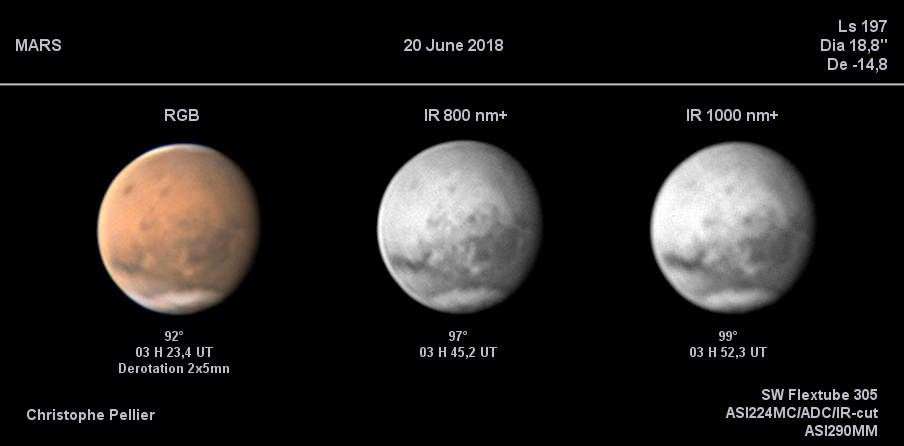 [Christophe Pellier Bruz City,France]
[Christophe Pellier Bruz City,France]
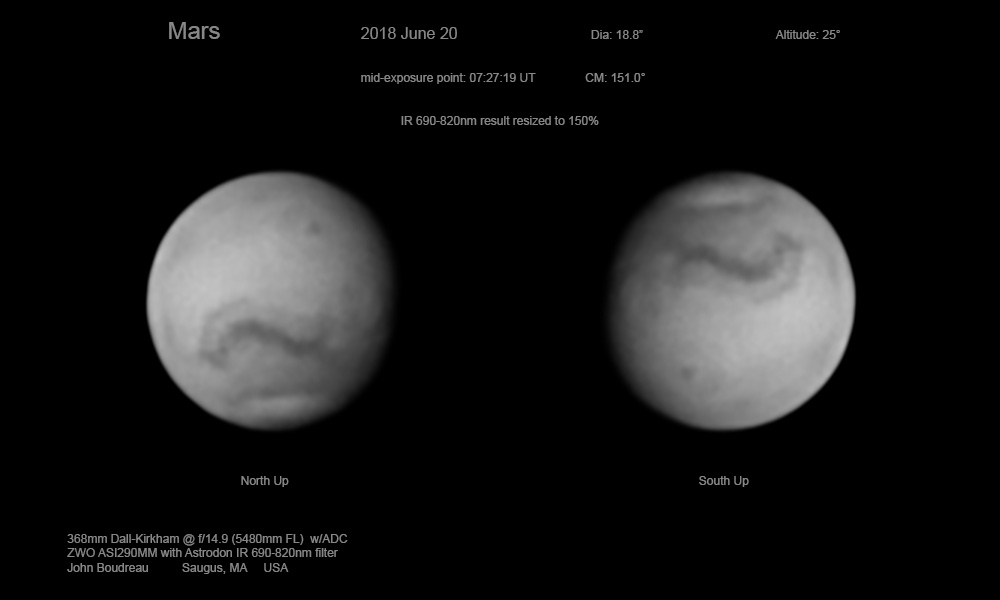
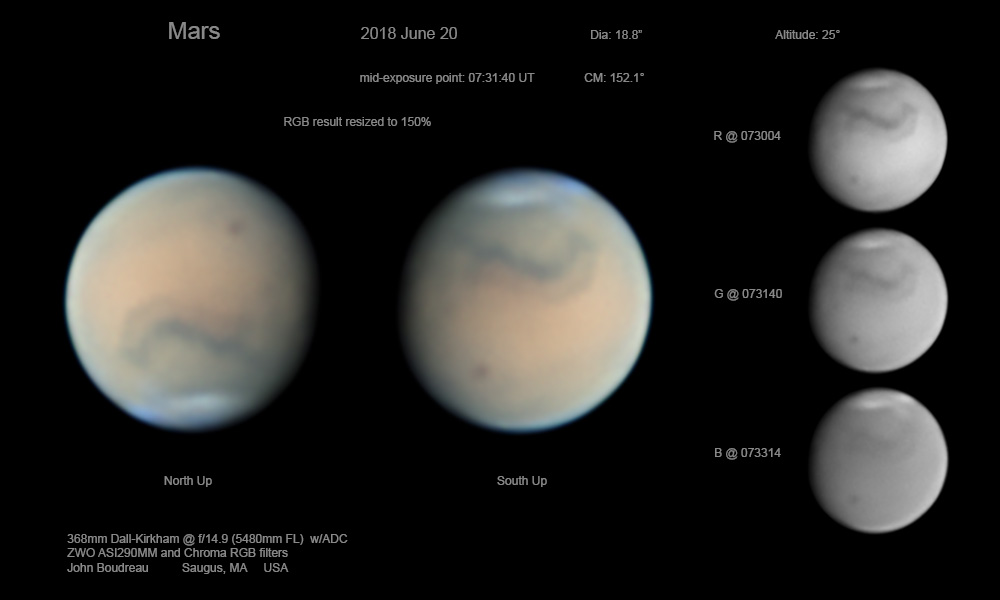 [ John Boudreau,Saugus,MA USA ]
[ John Boudreau,Saugus,MA USA ]
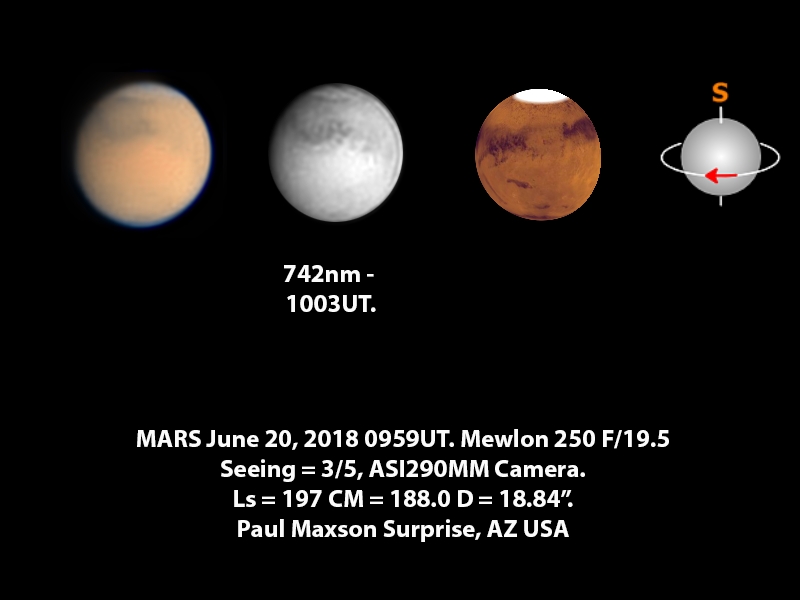 [ Paul Maxson:Surprise,Arizona,United States]
[ Paul Maxson:Surprise,Arizona,United States]

 -------------------------------------------------------------------------------------
-------------------------------------------------------------------------------------
 [Guilherme Grassmann,Americana-San Paulo,Brasil]
[Guilherme Grassmann,Americana-San Paulo,Brasil] Limited to a single IR capture yesterday evening.
Nice to see the familiar shape of Sinus Sabeaus and Sinus Meridiani starting to reappear through the dust.
Hopefully Opportunity rover will start seeing a bit of sunlight on its solar panels.
Limited to a single IR capture yesterday evening.
Nice to see the familiar shape of Sinus Sabeaus and Sinus Meridiani starting to reappear through the dust.
Hopefully Opportunity rover will start seeing a bit of sunlight on its solar panels.
 [Clyde Foster:Centurion,South Africa]
[Clyde Foster:Centurion,South Africa] [Stanislas Maksymowicz Ecquevilly,France]
[Stanislas Maksymowicz Ecquevilly,France]
 [Gary Walker:Georgia:USA]
[Gary Walker:Georgia:USA]
 [Antonio Lasala :Morata de Jalon:Spain]
[Antonio Lasala :Morata de Jalon:Spain]

 [スセンバッハ:オランダ]
[John Sussenbach:Houten,Netherlands]
[スセンバッハ:オランダ]
[John Sussenbach:Houten,Netherlands] The second image is an IR-RGB composite.
showing how Mars might appear if our eyes could see further into the infrared.
The second image is an IR-RGB composite.
showing how Mars might appear if our eyes could see further into the infrared.
 [Anthony Wesley,Murrumbateman Australia]
≪アンソニ オーストラリア≫
[Anthony Wesley,Murrumbateman Australia]
≪アンソニ オーストラリア≫ [ Observatory Parsec,City Canoas,Brazil]
[ Observatory Parsec,City Canoas,Brazil] [Gianluca Bianchi:Modena ITALY]
[Gianluca Bianchi:Modena ITALY] [Jean-Luc Dauvergne:Paris France]
[Jean-Luc Dauvergne:Paris France] [Christophe Pellier Bruz City,France]
[Christophe Pellier Bruz City,France]
 [ John Boudreau,Saugus,MA USA ]
[ John Boudreau,Saugus,MA USA ] [ Paul Maxson:Surprise,Arizona,United States]
[ Paul Maxson:Surprise,Arizona,United States] ALPO-Japan Latest
ALPO-Japan Latest